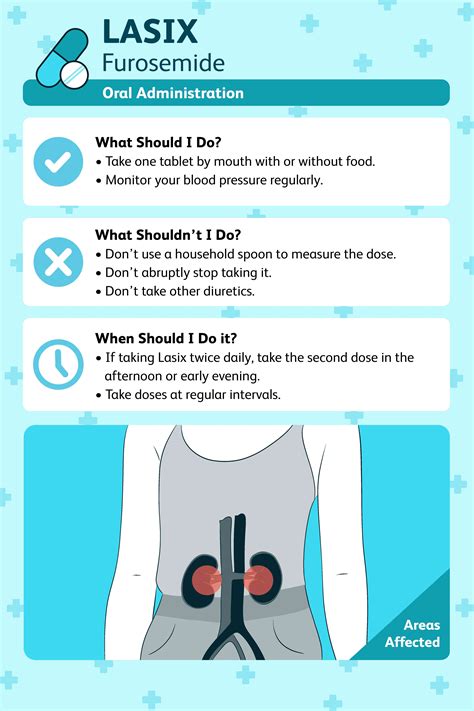Intro
Discover Furosemide 40mg Tablet uses, a diuretic medication for edema, hypertension, and fluid retention treatment, exploring its benefits, side effects, and interactions, for effective management of cardiovascular and kidney diseases.
Furosemide, commonly known by its brand name Lasix, is a medication that belongs to the class of loop diuretics. It is primarily used to treat conditions such as edema (swelling caused by excess fluid) and hypertension (high blood pressure). The 40mg tablet is one of the most commonly prescribed dosages for this medication. Understanding the uses, benefits, and potential side effects of Furosemide 40mg tablets is crucial for individuals who are prescribed this medication.
The importance of Furosemide 40mg tablets lies in their ability to help the body eliminate excess fluid and salt. This is particularly beneficial for patients suffering from conditions like heart failure, liver disease, or kidney disease, where fluid buildup can lead to serious complications. By promoting the excretion of fluid, Furosemide helps reduce swelling in the body and decreases the workload on the heart, thereby improving overall cardiovascular health.
For individuals taking Furosemide 40mg tablets, it's essential to understand how the medication works and its potential effects on the body. Furosemide acts on the kidneys to increase urine production, which in turn helps reduce fluid buildup in the body. This action is crucial for managing conditions like hypertension, where reducing fluid volume can help lower blood pressure. Furthermore, for patients with edema, the diuretic effect of Furosemide provides relief from swelling, improving mobility and comfort.
Furosemide Mechanism of Action

Benefits of Furosemide 40mg Tablets
The benefits of Furosemide 40mg tablets are multifaceted, offering relief from a range of symptoms associated with fluid buildup and hypertension. Some of the key benefits include: - Reduction in edema: Furosemide is highly effective in reducing swelling caused by excess fluid, improving mobility and comfort for patients. - Blood pressure management: By reducing fluid volume, Furosemide helps lower blood pressure, which is crucial for preventing complications associated with hypertension, such as heart disease and stroke. - Improved heart function: For patients with heart failure, Furosemide can help reduce the workload on the heart by eliminating excess fluid, thereby improving heart function and overall quality of life.Uses of Furosemide 40mg Tablets

Potential Side Effects
While Furosemide 40mg tablets are generally well-tolerated, they can cause several side effects, some of which may be severe. Common side effects include: - Increased urination: This is the most common side effect due to the diuretic action of Furosemide. - Dehydration: Excessive urine production can lead to dehydration if not balanced with adequate fluid intake. - Electrolyte imbalance: Furosemide can cause the loss of potassium and other electrolytes, which may require supplementation. - Dizziness and lightheadedness: These can occur due to dehydration or electrolyte imbalances.Precautions and Warnings

Interactions with Other Medications
Furosemide can interact with several medications, either enhancing their effects or increasing the risk of side effects. Some notable interactions include: - Other diuretics: Concurrent use can increase the risk of dehydration and electrolyte imbalances. - Antihypertensive drugs: Furosemide can enhance the blood pressure-lowering effect of these medications. - Lithium: Furosemide can increase lithium levels, potentially leading to toxicity.Dosage and Administration

Special Considerations
Certain patient populations require special consideration when taking Furosemide 40mg tablets. These include: - Pregnant women: Furosemide should be used with caution due to potential risks to the fetus. - Breastfeeding mothers: Furosemide is excreted in breast milk, and its use should be discussed with a healthcare provider. - Elderly patients: They may be more susceptible to the side effects of Furosemide, such as dehydration and electrolyte imbalances.Conclusion and Future Directions

Final Thoughts
Furosemide 40mg tablets offer a powerful tool in the management of edema and hypertension. By understanding their mechanism of action, benefits, and potential side effects, patients can better navigate their treatment plan. It's also crucial to adhere to the prescribed dosage and to monitor for any signs of adverse effects. With proper use and medical supervision, Furosemide 40mg tablets can significantly improve the quality of life for individuals suffering from fluid-related conditions.What is the primary use of Furosemide 40mg tablets?
+Furosemide 40mg tablets are primarily used to treat edema (swelling caused by excess fluid) and hypertension (high blood pressure).
How does Furosemide work?
+Furosemide works by inhibiting the sodium-potassium-chloride cotransporter in the kidneys, leading to increased urine production and reduction in fluid volume.
What are the common side effects of Furosemide 40mg tablets?
+Common side effects include increased urination, dehydration, electrolyte imbalance, dizziness, and lightheadedness.
Can Furosemide 40mg tablets be used during pregnancy?
+Furosemide should be used with caution during pregnancy due to potential risks to the fetus. It's essential to discuss the use of Furosemide with a healthcare provider.
How should Furosemide 40mg tablets be stored?
+Furosemide 40mg tablets should be stored at room temperature, away from moisture and light, and out of reach of children.
We invite you to share your thoughts and experiences with Furosemide 40mg tablets in the comments below. Your insights can help others better understand the benefits and challenges of this medication. Additionally, if you found this article informative, please consider sharing it with others who may benefit from this information. Together, we can promote a better understanding of health and wellness.
